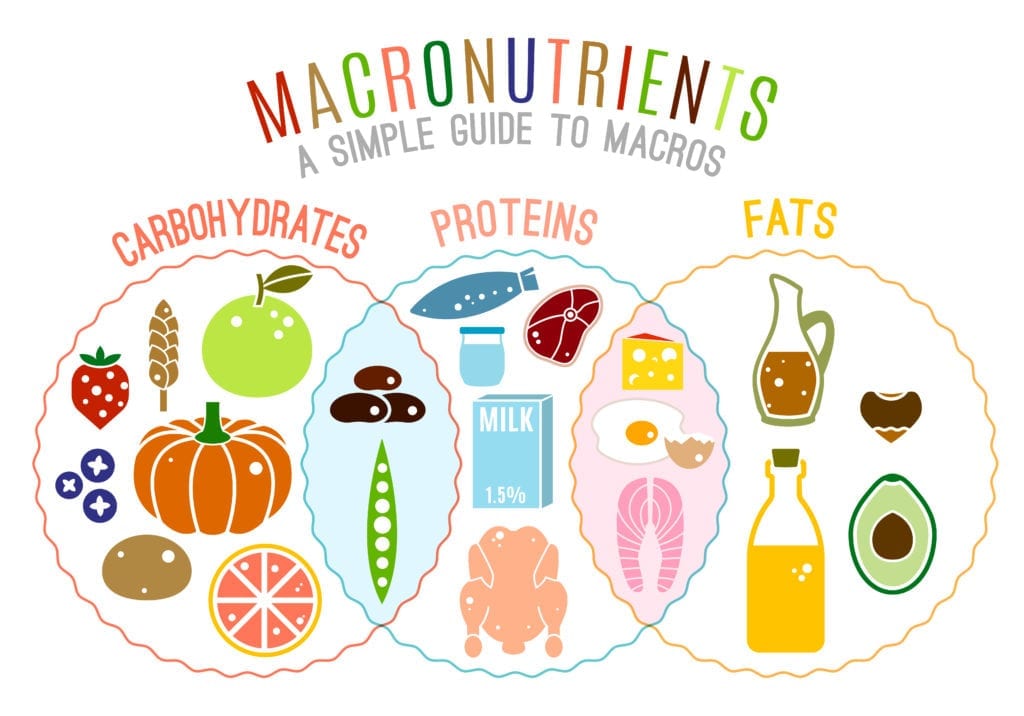What are Macros?
Macros is short for the word Macronutrients, which is the main nutrients that make the foods that we eat. There are three types of macronutrients: Carbohydrates, Protein, and Fats. Macronutrients are molecules that the help the body uses to create energy, so they are three sources of energy. Basically, they are the part of fuel that helps keep the body going. Macronutrients are found on the supplement fact panel on most products and are an essential part of any diet.
Carbohydrates:
Carbohydrates are macronutrients are the body’s main source of energy. They provide fuel for the central nervous system and energy for working muscles. Carbohydrates are important for brain function and can be a source for vitamins and minerals. So this may lead to the question, “if carbs are so good for your body, then why do people go on low-carb diets?” This is a great question. There are actually “bad” carbs and “good carbs. Examples of “good” carbohydrates include: vegetables, whole fruit, legumes, potatoes, and whole grains. Examples of “bad” carbs, or refined carbs include: fruit juices, white bread, white pasta, beverages that are sweetened with stevia. Carbs become bad when they are processed, refined, or when they are consumed in an overabundant amount.
Fat:
Dietary fats help give the body energy and helps to support muscle growth. Healthy fats also help to protect your organs, product important hormones, and keep your body at the right temperature. The key words here are “healthy” and “dietary fats” which means there are fats that are not good for the body. There are four major types of fats: 1. Saturated, 2. Trans fats, 3. Monounsaturated fats, and 4. Polyunsaturated fats. The bad fats are saturated and trans fats and include products such as butter, red meat, cheese, and ice cream (which are best in moderation). Good fats are monounsaturated and polyunsaturated fats such as vegetable oils (olive, sunflower, canola, etc.), nuts, seeds, and fish.
Protein:
Protein is a macronutrient that helps to build and maintain body tissue, and is essential to building muscle mass. Proteins are made up of amino acids, which are the building blocks of protein and muscle mass. Protein helps to build, maintain, and replace tissues in your body. Your muscles, organs, and immune system are made up mostly of protein.
There is a total of 20 different amino acids. Some of the amino acids can’t be made by the human body; they are essential amino acids. It is important that we take enough and balanced essential amino acids.
Foods that provide all the essential amino acids are called complete protein sources. Animal-based protein source normally are complete protein sources such as meat, fish, poultry, egg, milk, etc.
Most non-animal based protein source are incomplete. They may be low in one or more of the essential amino acids. However, eating different incomplete protein sources together can also provide sufficient protein needs for human health.
When you consume protein, it breaks down into amino acids during digestion and does a lot to keep your body running. Your body sends those amino acids to various parts of your body to keep them healthy and to help them grow. Blood is also made of protein and blood carries nutrients and oxygen throughout your body.
Counting Macros

Carbohydrates, proteins, and fats are the three essential macro-nutrients categories. We know the ratio is 45%,35%,20% carbs, proteins, fats but it is important to know how to incorporate them into your diet. Counting your macro-nutrients is important for incorporating the ratio properly. This is the breakdown of what each of those percentages mean:
-
- 1 gram of carbohydrates= 4 calories
- 1 gram of protein= 4 calories
- 1 gram of fat = 9 calories.
Why are the grams important? Because when you count the number of carbs, proteins, fats you need in your diet the percentages will mean grams. The grams are the daily intake and you will need to know this before counting macros.
-
- Daily protein intake: 1-1.7 grams of protein to every pound of in body weight
- Daily carb intake: 3.15 g to every kg in body weight.
- Daily protein intake: 1-1.7 grams of protein to every pound of in body weight
- Each of these intakes should be a total of 3000-5000 calories per day.
How to Count Macros:
Step 1: Calculate your daily calorie intake.
This is done by taking your body weight multiplied by your activity level.
Examples of activity level include: 14-inactive, 18- somewhat active, 20- extremely active.
If you are a person that weighs 150 lbs and are somewhat average it would be 150 x 18
So, the daily calorie intake is 2700 calories.
This would be your recommended calorie intake for just a normal lifestyle- not for gaining muscle mass.
Step 2: Since you are bulking/gaining muscle mass the daily recommended calorie count needs to be increased.
Increase calories by 250-500 (if cutting you would decrease by the same).
Say you choose a goal and you want to increase the calories by 300
2700+ 300= 3000
A person that is 150 lbs and a daily intake of 2700 calories would then be eating 3000 calories while working out and trying to gain muscle.
Step 3: Calculate daily protein intake. Since protein needs to be 35% of diet and 1 gram of protein equals 4 calories:
Multiple grams of protein by body weight.
150 lbs x 1 gram of protein= 150 grams of protein a day
Since 1 gram of protein =4 calories. Multiple 150 times 4
150 x 4= 600
The daily protein intake is 600 calories.
Subtract 600 from 3000 and your remaining calories: 2400
In summary: 150g or 600 calories of protein per day
Step 4: Calculate daily fat intake. since fat needs to be 20% of diet and 1 gram of fat is equal to 9 calories.
Multiple remaining calories by .20
2400 x 9= 480
Divide by 9 since that’s the number of calories
480 / 9 = 53.3 so 54
54g of fat per day.
54 times 9= 486 calories
Subtract 486 from 2400 and your remaining calories: 1914
In summary: 54g or 486 calories of fat per day.
Step 5: Calculate daily carbs intake.
Divide remaining calories by 4.
1914/ 4= 478.5 g
478.5 g or 1914 calories of carbs per day.
Step 6. Add up each number of calories to ensure each step was correctly calculated.
Protein: 600 calories
Fat: 486 calories
Carbs: 1914 calories
Total calories per day: 3000
Diet & Meals:
Once you’ve calculated your macros, you need to increase meals from 3 to 6 a day per the additional number of calories you’ve added to your daily regimen for muscle mass gain. Timing is everything, and it is important to eat or drink something high in protein before a workout and after a workout. We discuss post workout meals later in this blog. Timing is everything, and it is important to eat or drink something high in protein Also, in each meal it is important to have at least 3 of the 5 food groups:
Grains, Fruits, Vegetables, Dairy, and some type of meat whether it be meat, poultry, or fish.
Snacks to Eat When Gaining Muscle: nuts, dried plums, celery, apricots, edamame, pumpkin seeds, strawberries, plain Greek yogurt, string cheese, protein bars/shakes/smoothies
Macros in Supplements
Most nutritional supplements have the three main macronutrients. There are some supplements such as meal replacement shakes that contain all three and can help add to the daily macros an athlete or bodybuilder needs. There is always a need to keep these three macronutrients in supplements. Supplements can help one reach their fitness goals and to stay on track while counting macros. While supplements should not completely replace meals, they are definitely a huge part of the overall fitness routine and can greatly benefit health and fitness goals.
How does this affect the Supplement Industry?
Macronutrients do not negatively affect the supplement industry. Macronutrients are not just a trend that is here today and gone tomorrow. In fact, counting macronutrients has been around 1900s and is still a very popular practice today. As a manufacturer in the supplement industry, it is crucial to create products that can help people stay on track with their macros. This includes making sure that the ingredients and supplement fact panels align so that they can fit into the daily calorie quantity.
Marissa Spade
Marissa graduated from Robert Morris University in May 2018 with a Bachelor of Science in Marketing. She started her career with SDC Nutrition as an intern during her college years and under the guidance of the co-founder Devenee Schumacher she has been an integral part of the Digital and Social Marketing presence for the company.
Internally she claims the token “Millennial” role of the team, but she is involved in every aspect of the digital face of the company from copy writing, public relations, affiliate management, ambassador management, and content creation. Since becoming a full-time member of the team she has most notably launched over 100 published articles for the company and its brands & she has successfully on-boarded over 500 affiliates in the company’s innovative Affiliate program.
Spade is set to launch new innovative content for all of the brand profiles which she is solely responsible for this year and her upcoming national campaigns are set to exponentially increase the overall audience for the company. Stay tuned for her upcoming accomplishments… you won’t want to miss the updates!
